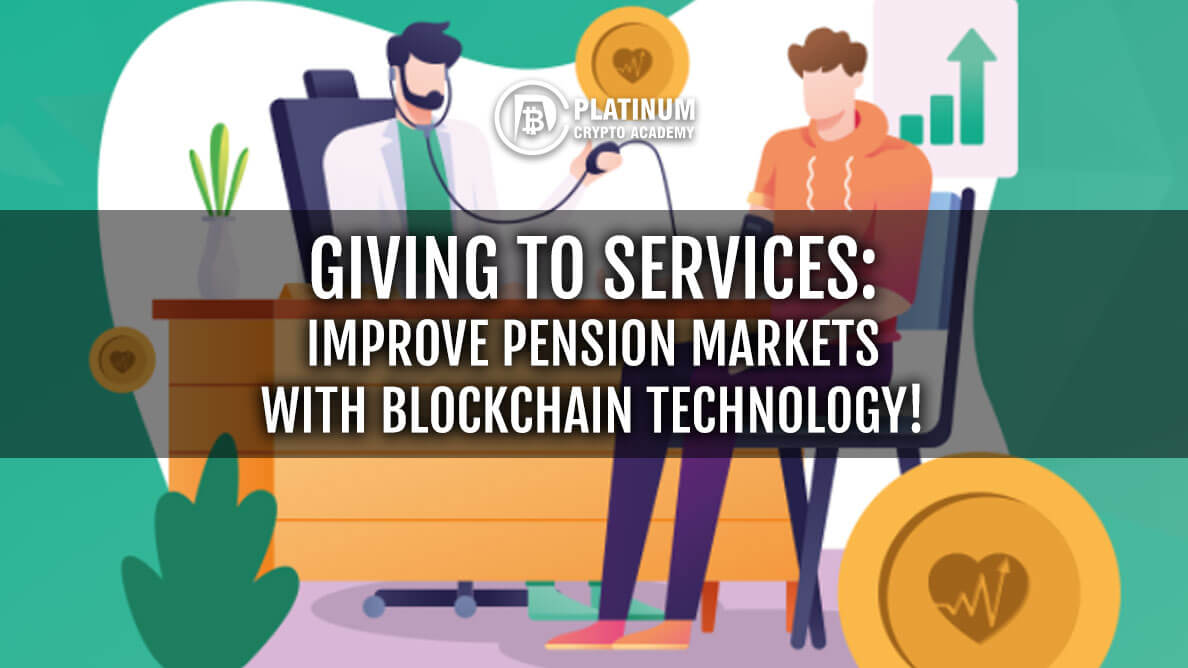Giving To Services is a decentralised financial (DeFi) service that harnesses blockchain technology to empower those involved in public services, including the medical, education, emergency services, government and council professions. The whole platform is powered by an audited digital token known as the SVS, based on the ERC20 platform, which enables secure, transparent financial interactions between individuals, charities, institutions and other organisations connected with the provision of public services.
Giving To Services provides an alternative way to fund the public servants that perform society’s most undervalued and unrecognised duties. The platform empowers individuals and institutions to fund those involved in government and public services directly and transparently – plus, it is also creating a next generation public service pension too!
While traditional pensions are normally locked by governments until the person reaches the ‘pensionable age’, Giving To Services is built to be much more flexible. Rather than waiting for a magical old age (which is always being moved further away), SVS allows you to be your own decision maker. SVS intends to truly revolutionise pensions for those who need it the most.
It provides an alternative way to fund the public servants and save for retirement.
What are the problems in pension markets?
The challenges to public and government service workers are set against a wider backdrop of societies that are constantly shifting in terms of working patterns, opportunities and social norms with the moving world. With more and more people seeking freelance work and short-term employment, plus travelling more frequently to work, traditional approaches to pension services are getting outdated. The lack of any kind of international jurisdiction framework for inter-countries pension management further complicates the situation. Any solution for a next generation of pension services must take into account the existing framework of the pension products and enable the systems to run in parallel while trust is built and the new solution is refined with multiple iterations. Given the threats posed to the traditional systems, it is understandable that the early adopters will be cautious and there will be inertia to adopt any system that is developed as an improvement. Therefore, to make it adaptable, flexible and open must be key additions of any new age solutions for digital pensions if they are to be sustainable and valuable in the long term. Despite the concerns that people may have about increased personal responsibility for long-term financial health, many financial advisers already recommend their clientele to do this. Self-managed pensions have become increasingly popular, with many choosing to withdraw their pension money as a single lump sum payment, enabling them to direct their investment of their choice according to their investment appetite and risk. By minimising the involvement of third party (middle men) in the investment process, the potential for great long-term return increases enhancing cost savings. Advisers and customers are aware of the benefits of increasing personal responsibility when it comes to pensions, and many will welcome the access to purpose-made blockchain technology and will progress in this direction. Provision of the tools needed to increase personal responsibility, in tandem with access to carefully analysed investment opportunities, can enable a larger section of people to generate better returns from their life savings than would be the case if relying purely on third parties with little directly vested interest in the outcome.
Introduction to staking: How it works
Staking is a concept that you’ll hear frequently in the crypto world. Staking is the process by which many cryptocurrencies verify their transactions, and it allows participants to earn rewards on their holdings.
But what is staking in cryptocurrencies? Staking cryptocurrencies is a process that involves making your crypto assets available to support a blockchain network and confirm transactions.
Cryptocurrencies that use the proof-of-stake model to process payments can be staked. This is a more of an energy-efficient alternative to the proof-of-work model, which requires mining devices that use computing power to solve mathematical equations consuming a lot of energy.
Staking is a good way to use your crypto to generate passive income, especially because some stable cryptocurrencies offer decent interest rates for staking. So how does staking work?
With cryptocurrencies that work on the proof-of-stake model, staking is how new transactions are added to the blockchain. Participants pledge their coins to this cryptocurrency protocol. From those participants, the protocol chooses validators to confirm blocks of transactions and the more coins you pledge, the chances are higher of you being chosen.
Every time a block is added to the blockchain network, new coins are minted and entered into the system as staking rewards to that block’s validator. The rewards are usually denominated in same cryptocurrency as that of the staked coin, though some blockchains provide a different cryptocurrency as reward.
If you want to stake your cryptocurrency, you have to own a crypto coin that uses the proof-of-stake model. Then you can choose the amount you want to stake. You can do this through many prominent cryptocurrency exchanges.
You still have possession of your coins when you stake them. You’re essentially putting them to work to earn rewards for you, and you are free to unstake them if you want to trade them later. The unstaking process may require some time, depending on the cryptocurrency, and, with some cryptocurrencies, you’re required to stake coins for a minimum amount of time.
Staking isn’t possible with all types of cryptocurrency. Many cryptos use the proof-of-work model to add blocks to their blockchains. The main drawback with proof of work is that it requires considerable computing power and hence, a significant amount of energy. Bitcoin in particular has been criticised due to environmental concerns.
Proof of stake, on the other hand, doesn’t require nearly as much energy. This also makes it a more scalable option that can handle greater numbers of transactions.
Benefits of staking crypto
Here are the benefits of staking crypto:
- Easy way to earn interest on your cryptocurrency assets.
- No major computing equipment is required for crypto staking as you would for crypto mining.
- You are maintaining the security and efficiency of the blockchain.
- As discussed, it is more environmentally friendly than crypto mining.
The primary benefit of staking is that you earn more crypto through your existing coins, and interest rates can be very good. For some stable coins, you can earn more than 10% or 20% per year. It’s a very profitable way to invest your coins, and in the meanwhile, you earn capital gains too. And the only thing you need is a crypto coin that relies on the proof-of-stake model.
Staking is also a way of supporting the blockchain of a cryptocurrency you’re invested in. These cryptocurrencies rely on holders staking to verify transactions and keep everything running smoothly.
Risks of staking crypto
There are a few risks of staking crypto to know about:
- Crypto currencies are volatile and can tank. If your staked coins suffer a major slump, that could outweigh any interest you earn on them.
- Staking requires you to lock up your coins for a minimum amount of time. During that period, you’re unable to trade or do anything with your staked crypto holdings.
- When you want to unstake your crypto, there may be an unstaking period of seven days or longer, which varies for different coins and exchanges.
- One of the biggest risks you face with crypto staking is that the price goes down. Keep this in mind if you have cryptocurrencies that are offering extremely high interest rates. Many smaller crypto projects initially entice investors, but their prices often crash. If you’re interested in adding crypto to your portfolio, but you’d prefer less risk, you may want to opt for stable cryptocurrency coins instead.
- Although crypto that you stake is still yours, you need to unstake it before you can trade it in the market again. It’s important to find out the terms and conditions regarding the minimum lock-in period and the duration of the unstaking process.
How SVS platform help users to earn passive income with staking
Platform users of the SVS platform can generate a passive income stream through staking. The SVS platform enables users to take their SVS tokens, stake them into a specific investment basket and earn rewards (interest) from that network. The platform has researched extensively and aims to simplify the complicated procedure of staking by offering three different staking investment baskets. The first investment basket is the wrapped Bitcoin. As Bitcoin is on a Proof of Work network, where you need computational power to confirm transactions on the network instead of Proof of Stake, normally, you won’t see Bitcoin in a staking protocol. However, there are upcoming projects out there that have managed to create a “wrapped Bitcoin”, where you have Bitcoin “wrapped” within a layer on the Ethereum Standard – ERC20. This version of Bitcoin is called wBTC and is a 1:1 representation of Bitcoin as the original one and directly connected. As decentralised finance itself is still looking towards Bitcoin, the wBTC token is utilised in many protocols.
The SVS platform also enables its users to take their SVS tokens and stake them into 3 different staking baskets. The platform takes the representation of SVS and it automatically triggers an underlying staking into wBTC, USDT and EURS, depending on where the user chooses to stake. Each have their own yield percentage. The rewards are paid out in SVS on a regular basis.
How SVS solves public service challenges
In the initial stages, the SVS platform is being used as a platform to attract investment into projects that directly help those who have served their nations in public service and government roles. As funds become readily available, they are appropriately directed to market SVS and to increase capacity for funding of worthy public service causes and reasons. Increased awareness of the SVS token and the related digital currency ecosystem empowers SVS to partner with other key projects and organisations, enabling greater opportunity for growth, development and innovation. Through cooperation with strategic partners, the value of SVS grows both as a functional tool to provide support to public services and as a store of value for token holders. Through investing in SVS, token holders are indirectly investing in public services and also supporting the Giving To Services project that further develops solutions that helps all the parties. Initial token sales serve as a head start to power up the financial and technological engine that is collectively responsible for moving towards our goal of financial security for public service workers. Initial focus will be on branding, marketing and growing public awareness in order to provide a solid foundation for future development and the introduction of world-changing features and services.
CONCLUSION
Giving To Services and the SVS platform provide a plethora of ideas that present an opportunity for tech-savvy societies to strengthen their essential services and core infrastructure from the foundation levels. Financial, governmental and commercial institutions are authorised to interact with individual service workers in a more even and transparent fashion than has not been traditionally possible. Through the cumulative and combined efforts of technology, finance and public service experts, long-standing threats to society’s wellbeing can be addressed successfully and in ways that benefit all involved.
Hopefully, you have enjoyed today’s article. Thanks for reading! Have a fantastic day! Live from the Platinum Crypto Trading Floor.
Earnings Disclaimer: The information you’ll find in this article is for educational purpose only. We make no promise or guarantee of income or earnings. You have to do some work, use your best judgement and perform due diligence before using the information in this article. Your success is still up to you. Nothing in this article is intended to be professional, legal, financial and/or accounting advice. Always seek competent advice from professionals in these matters. If you break the city or other local laws, we will not be held liable for any damages you incur.


